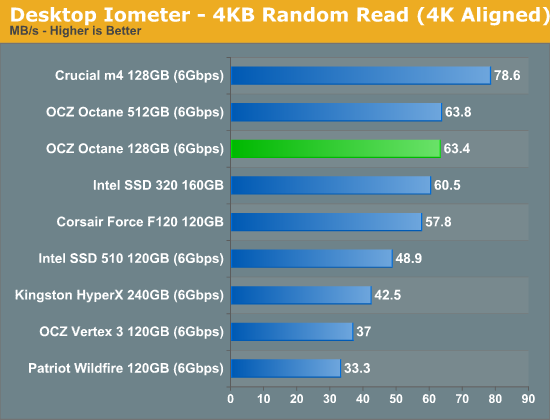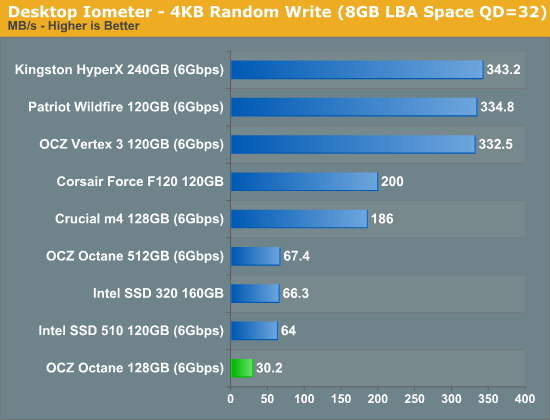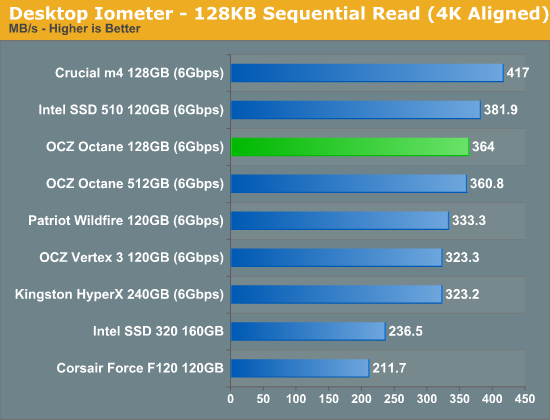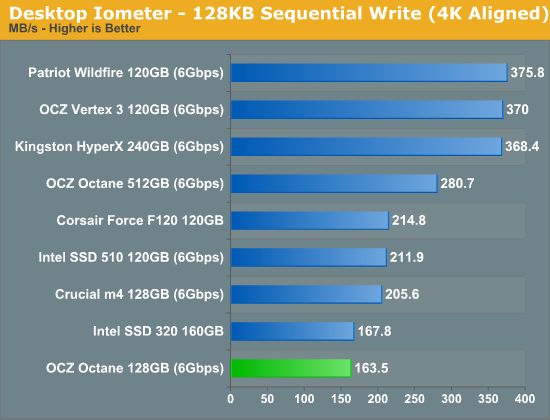OCZ Octane 128GB SSD Review
by Anand Lal Shimpi on December 28, 2011 12:27 AM ESTRandom Read/Write Speed
The four corners of SSD performance are as follows: random read, random write, sequential read and sequential write speed. Random accesses are generally small in size, while sequential accesses tend to be larger and thus we have the four Iometer tests we use in all of our reviews.
Our first test writes 4KB in a completely random pattern over an 8GB space of the drive to simulate the sort of random access that you'd see on an OS drive (even this is more stressful than a normal desktop user would see). I perform three concurrent IOs and run the test for 3 minutes. The results reported are in average MB/s over the entire time. We use both standard pseudo randomly generated data for each write as well as fully random data to show you both the maximum and minimum performance offered by SandForce based drives in these tests. The average performance of SF drives will likely be somewhere in between the two values for each drive you see in the graphs. For an understanding of why this matters, read our original SandForce article.

Random read performance remains untouched with the move to 128GB, although random write performance is cut in half compared to the 512GB version:

Many of you have asked for random write performance at higher queue depths. What I have below is our 4KB random write test performed at a queue depth of 32 instead of 3. While the vast majority of desktop usage models experience queue depths of 0 - 5, higher depths are possible in heavy I/O (and multi-user) workloads:

Sequential Read/Write Speed
To measure sequential performance I ran a 1 minute long 128KB sequential test over the entire span of the drive at a queue depth of 1. The results reported are in average MB/s over the entire test length.

Sequential read performance is once again untouched compared to the larger capacity Octane, while sequential write performance is seriously impacted:











38 Comments
View All Comments
jramskov - Wednesday, December 28, 2011 - link
My desktop (i7-920 based, Win7 64bit) currently have a 160GB Intel G2 as a boot drive, but my data drive is currently an older 500GB Seagate.Workload: Primarily editing images in Lightroom, etc. (compressed RAW files from a Nikon D700 currently).
I would like to replace the Seagate with a 256GB SSD, but which one would be recommended for such a workload?
Denithor - Wednesday, December 28, 2011 - link
Standard recommendations are:Intel 320
Crucial M4
Samsung 830
All are known for high dependability. Last two use sata III controllers, which you do not currently have on your system, but would become faster when you eventually upgrade your system. (And will therefore remain competitive longer.)
jramskov - Wednesday, December 28, 2011 - link
Thanks.I was thinking along those lines and not the Sandforce based as I'm generally working with compressed data.
And true, I don't have sata III controllers, but I don't think my system is worth upgrading just yet :)
JackF - Wednesday, December 28, 2011 - link
I have a similar system (i930) and currently have a OCZ Max IOPs 120gb for my boot drive, and an OCZ Vertex 3 120gb as my game drive (along with a 600gb Velociraptor for data).When I first got the MAX IOPs drive, I had occasional issues with the drive disappearing (would need a reboot), but with the firmware updates, this drive has been running for 2-3 months with no problems. I never had any problems with the Vertex 3, but I got it later and it had newer firmware.
I think the reliability issues have been resolved with the Sandforce 2281 controller and I would not rule these out as they have come down in price.
Even if you add an SSD for working with your large photo data, Keep the Seagate as a data back-up.
jramskov - Thursday, December 29, 2011 - link
I was avoiding the Sandforce based SSD's because they are best for data that can be compressed, my images are already compressed. Images are relatively big (spanning from 5-15MB or so), so my thinking is that I should be looking at sequential read/write performance and less on random read/write performance.I have no doubt though that almost no matter what SSD I choose, I will get a quite nice performance boost.
JonnyDough - Wednesday, December 28, 2011 - link
He could also get a SATA 6GB/s controller card.ckevin1 - Wednesday, December 28, 2011 - link
Be careful of this -- the total bandwidth of a PCI-e 1x slot is only 500 mb/s. That's less than the maximum SATA III speed, and if you hook up more than one drive you could actually cap out at less than SATA II performance for each disk.Maybe there are more expensive adapter cards that plug into a different PCI-e slot, but I would be inclined to only rely on motherboard connections for true SATA III speeds for the time being.
StanFL - Wednesday, December 28, 2011 - link
Good review. In the last paragraph on the final page, myriad is spelled incorrectly.Denithor - Wednesday, December 28, 2011 - link
No spell checker? Sheesh...JonnyDough - Wednesday, December 28, 2011 - link
You must be new here. And by here I mean the internet...Education in America is at an all time low.